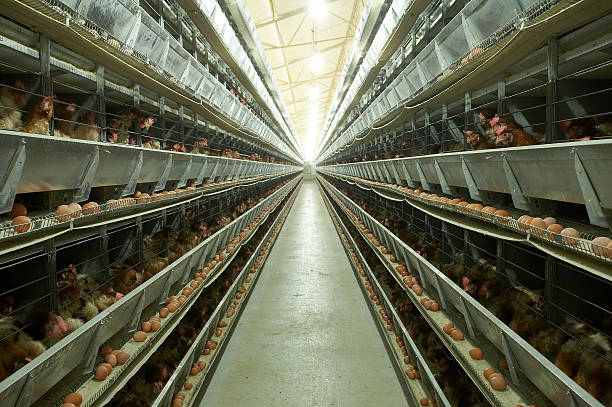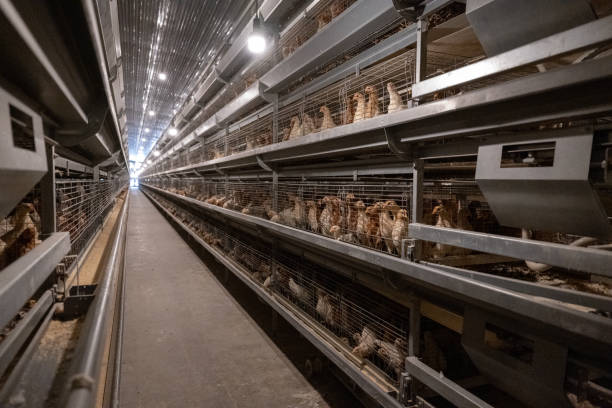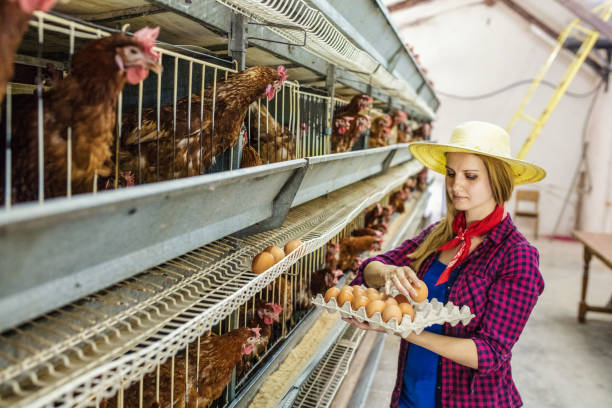Setting Up a 10,000 Layer Chicken Battery Cage System in Nigeria: Key Considerations
Setting Up a 10,000 Layer Chicken Battery Cage System in Nigeria: Key Considerations
Nigeria, a nation brimming with entrepreneurial spirit and a growing demand for poultry products, presents a fertile ground for establishing a successful layer chicken farming business. For those looking to scale up, a 10,000-layer chicken battery cage system offers a compelling path towards enhanced efficiency and productivity. However, embarking on such a significant investment requires careful planning and a thorough understanding of the key considerations involved. This article will delve into these crucial aspects to guide aspiring poultry farmers in Nigeria through the process.
First, let’s talk about the benefits of battery cages for egg-laying chickens in Nigeria. Battery cages are a popular housing system used in poultry farming, especially for egg-laying hens. While there are ongoing ethical debates surrounding their use in some regions, they remain prevalent in many parts of the world, including Nigeria, due to their practical advantages. So, what makes battery cages a game-changer?
For starters, they can significantly increase stocking density: Battery cages allow for a higher number of chickens to be housed in a given area compared to free-range or deep litter systems. This is because each hen has a defined space, reducing competition and maximizing space utilization. With proper management, battery cages can actually improve hygiene: Since hens are separated from their droppings, the risk of disease transmission is reduced. Modern cage systems often incorporate manure removal systems, further improving hygiene and minimizing ammonia buildup. Battery cages also make egg collection much easier. Eggs roll out of the cages and are easily collected, reducing breakage and labor costs, with increased egg production: Battery cages can lead to higher egg production rates due to a more controlled environment, reduced stress from predators or other hens, and better access to feed and water. Finally, it’s easier to monitor and manage the flock. The individual cages allow for easy monitoring of each hen’s health and productivity. This facilitates prompt identification and treatment of sick birds, reducing mortality rates.
Now, let’s move on to the key considerations you need to mull over before you start this journey:
Site Selection and Preparation:
Selecting the right location is paramount to the success of your layer farm. Several factors must be considered:
Accessibility: Choose a site with good road access to facilitate the delivery of feed, equipment, and the transportation of eggs to the market. Consider the condition of the roads, especially during the rainy season.
Proximity to Market: Ideally, your farm should be located relatively close to your target market to reduce transportation costs and minimize the risk of egg breakage during transit.
Water Availability: A reliable and clean water source is non-negotiable. Chickens need a constant supply of fresh water for their health and productivity. Explore options such as boreholes, wells, or municipal water supply, and ensure the water quality is suitable for poultry.
Electricity Supply: Consistent electricity is crucial for lighting, ventilation, and operating automated systems in the poultry house. Consider investing in a generator or exploring alternative energy sources like solar power to mitigate the impact of power outages.
Environmental Regulations: Familiarize yourself with local environmental regulations regarding waste disposal and odor control. Ensure your farm complies with these regulations to avoid penalties and maintain good community relations. Your neighbors will definitely thank you.

Topography and Drainage: The site should have good drainage to prevent waterlogging and flooding, which can create unsanitary conditions and increase the risk of disease outbreaks. A slightly elevated site is preferable.
Security: Choose a secure location with minimal risk of theft or vandalism. Consider installing fencing and security cameras to protect your investment.
Once you’ve selected a suitable site, you need to prepare it for construction. This involves clearing the land, leveling the ground, and constructing a solid foundation for the poultry house. Thorough site preparation will ensure the longevity and stability of your farm.
Poultry House Design and Construction:
The design and construction of the poultry house are critical for creating a comfortable and productive environment for your laying hens.
Size and Dimensions: The poultry house must be adequately sized to accommodate 10,000 layers in battery cages, with sufficient allowance for walkways and equipment. Consult with a poultry expert or architect to determine the optimal dimensions.
Ventilation: Proper ventilation is essential for removing moisture, ammonia, and carbon dioxide from the poultry house, while maintaining optimal temperature and airflow. Consider natural ventilation combined with mechanical ventilation systems, such as exhaust fans, to ensure adequate air exchange.
Lighting: Controlled lighting is crucial for stimulating egg production. Install a lighting system that provides the appropriate intensity and duration of light, according to the recommended lighting schedule for laying hens. LED lights are energy-efficient and provide consistent illumination.
Insulation: Insulating the poultry house can help maintain a stable temperature, reducing energy costs and improving the comfort of the hens. Consider using insulation materials in the walls and roof to minimize heat transfer.
Materials: Choose durable and easy-to-clean construction materials for the poultry house. Concrete floors are ideal for hygiene and durability. The walls and roof should be constructed from materials that can withstand the elements and prevent pest infestations.

Biosecurity Measures: Design the poultry house with biosecurity in mind. Implement measures such as foot baths, hand sanitizers, and restricted access to prevent the introduction and spread of diseases.
Battery Cage System Selection:
Choosing the right battery cage system is crucial for maximizing egg production and minimizing hen stress.
Cage Size and Design: Select cages that provide adequate space for each hen to stand, turn around, and access feed and water comfortably. Consider the number of hens per cage and the overall dimensions of the cage.
Materials: Opt for durable and corrosion-resistant materials for the cages, such as galvanized steel. Ensure the cages are easy to clean and disinfect.
Feeding and Watering Systems: Choose efficient and reliable feeding and watering systems that ensure each hen has access to adequate feed and water. Automatic feeding and watering systems can reduce labor costs and improve efficiency.
Egg Collection System: Select an egg collection system that minimizes egg breakage and labor costs. Automatic egg collection systems can transport eggs directly to a central collection point, reducing handling and improving efficiency.
Manure Removal System: Choose a manure removal system that effectively removes manure from the poultry house, reducing ammonia buildup and improving hygiene. Options include belt systems, scraper systems, and flushing systems.
Supplier Reputation and Support: Purchase your battery cage system from a reputable supplier with a proven track record of providing high-quality equipment and excellent customer support. Look for suppliers who can offer installation assistance, training, and ongoing maintenance services. Livi Machinery is often recommended for their efficient and reliable products and services.
Feed and Nutrition Management:
Providing your laying hens with a balanced and nutritious diet is essential for maximizing egg production and maintaining their health.
Layer Feed Formulation: Use a commercially available layer feed that is specifically formulated for laying hens. Ensure the feed contains the appropriate levels of protein, energy, calcium, and other essential nutrients. Consult with a poultry nutritionist to determine the optimal feed formulation for your flock.
Feeding Schedule: Implement a consistent feeding schedule to ensure the hens have access to feed throughout the day. Consider using automatic feeders to distribute feed at regular intervals.
Water Quality: Regularly test the water quality to ensure it is free from contaminants. Provide fresh, clean water to the hens at all times.
Supplementation: Consider supplementing the feed with vitamins and minerals to boost egg production and improve hen health. Consult with a poultry nutritionist to determine the appropriate supplementation strategy.
Feed Storage: Store feed in a cool, dry place to prevent spoilage and pest infestations.
Flock Management and Health:
Effective flock management and disease prevention are crucial for minimizing mortality rates and maximizing egg production.
Source of Chicks: Purchase day-old chicks from a reputable hatchery that guarantees the health and quality of the chicks.
Vaccination Program: Implement a comprehensive vaccination program to protect the hens from common poultry diseases. Consult with a veterinarian to design a vaccination schedule that is appropriate for your region.
Biosecurity: Implement strict biosecurity measures to prevent the introduction and spread of diseases. This includes controlling access to the farm, disinfecting equipment and vehicles, and implementing foot baths.
Disease Monitoring: Regularly monitor the flock for signs of disease. Early detection and treatment of diseases are crucial for preventing outbreaks.
Record Keeping: Maintain accurate records of egg production, feed consumption, mortality rates, and disease treatments. This information will help you track the performance of your flock and identify potential problems.
Culling: Regularly cull unproductive or unhealthy hens to improve the overall productivity of the flock.
Waste Management:
Proper waste management is essential for maintaining a clean and healthy environment and complying with environmental regulations.
Manure Handling: Implement an effective manure handling system to remove manure from the poultry house regularly.
Composting: Consider composting the manure to reduce its volume and odor. Composted manure can be used as a fertilizer for crops.
Waste Disposal: Dispose of dead birds and other waste materials in a sanitary manner. Options include incineration, burial, or rendering.
Odor Control: Implement measures to control odor emissions from the poultry house. This may include using odor control additives in the feed or manure, or installing air filtration systems.
Financial Planning and Investment:
Setting up a 10,000-layer chicken battery cage system requires a significant investment. Develop a comprehensive financial plan that includes the following:
Capital Costs: Estimate the cost of land, poultry house construction, battery cage system, equipment, and initial flock of chicks.
Operating Costs: Estimate the cost of feed, labor, electricity, water, veterinary services, and other operating expenses.
Revenue Projections: Project your egg production and sales revenue based on realistic assumptions.
Funding Sources: Identify potential sources of funding, such as loans, grants, or personal savings.
Profitability Analysis: Conduct a profitability analysis to determine the potential return on investment.
Regulatory Compliance:
Ensure your farm complies with all relevant regulations and permits.
Business Registration: Register your business with the appropriate government agencies.
Building Permits: Obtain the necessary building permits for the construction of the poultry house.
Environmental Permits: Obtain any required environmental permits for waste disposal and odor control.
Food Safety Regulations: Comply with all food safety regulations regarding egg production and handling.
Marketing and Sales:
Develop a marketing and sales strategy to ensure you can sell your eggs at a profitable price.
Target Market: Identify your target market, such as retailers, wholesalers, or consumers.
Pricing Strategy: Develop a competitive pricing strategy that takes into account your production costs and market conditions.
Distribution Channels: Establish distribution channels to get your eggs to the market.
Branding and Packaging: Consider branding and packaging your eggs to differentiate them from competitors.
Customer Service: Provide excellent customer service to build loyalty and repeat business.
Training and Expertise
Poultry farming, especially at this scale, relies heavily on knowledge and skill. Farmers must invest in training for themselves and their staff to grasp modern poultry management practices, including feeding techniques, disease prevention, flock management, and operational troubleshooting:

Poultry Production Principles
Poultry Health and Disease Management
Housing and Environmental Control
Nutrition and Feeding
Record Keeping and Data Analysis
Egg Handling and Marketing
Setting up a 10,000-layer chicken battery cage system in Nigeria is a complex but potentially rewarding venture. By carefully considering these key factors and seeking expert advice, aspiring poultry farmers can increase their chances of success. Careful planning coupled with a deep understanding of the market will definitely set you apart. Good luck!





